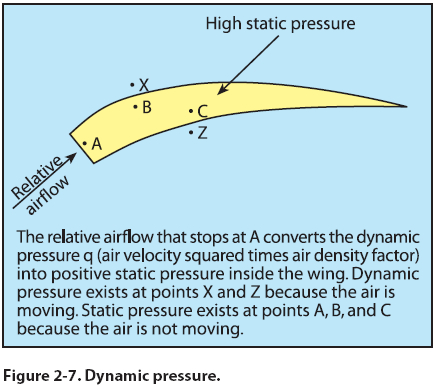Chapter 2 - Aerodynamics of Flight
Powered Parachute Wing Pressurization and Flexibility
The powered parachute has two distinctive modes: (1)
inflated, it is a ram-air wing with a curved arc—
a recognizable
airfoil shape; and (2) deflated, it is a canopy
that is either lying flat on the ground or packed into
a bag.
Note: Chapter 7, Takeoffs and Departure Climbs, will
detail the methods of getting the uninflated canopy
laying on the ground turned into a flying wing. Since
the aerodynamics of the PPC do not start until the
wing is completely inflated, this chapter will assume
each reference to the PPC wing is to an inflated ramair
wing already in the shape of an airfoil.
The powered parachute ram-air wing retains its airfoil
shape due to the air pressurizing the inside cells
via the relative wind airflow being rammed into the
front openings of the canopy—thus the term “ram-air
wing.” The pressure inside the wing is much higher
than the outside top and bottom because the dynamic
pressure from the relative wind is converted to static
pressure to pressurize the wing. The greater the speed,
the greater the pressure inside the wing and the more
rigid the wing. The cell openings are designed to be
perpendicular to the relative wind to achieve maximum
pressure from the relative wind. This static internal
pressure harnessed from the relative wind is
called dynamic pressure (q), and is determined by the
velocity squared times the air density factor. [Figure
2-7] Note the dynamic air pressure converted to static
pressure at point A is constant throughout the wing
points B and C. This static pressure is always greater
than the pressure outside the wing at points X and Z.

Cross-port openings are placed in the ribs of each cell,
connecting the adjoining cells. These cross-ports are
dispersed throughout the wing (with exception to the
outboard side of the end cells) to maintain positive
pressure throughout. The pressure is constant inside the wing because the dynamic pressure hitting the
opening is the same for each cell and the speed is
the same. The cross-ports aid the complete wing in
becoming pressurized during inflation and maintaining
the pressure throughout the wing in turbulence.
[Figure 2-8]

The inflatable wing airfoil generally remains a consistent
shape as designed by the manufacturer. However,
pilot control of the wing to make a turn significantly
changes the relative aerodynamic qualities of the PPC
wing by pulling down the trailing edge similar to a
flap on an airplane. [Figure 2-9]

Faster speeds from smaller wings or more weight create
a higher pressure in the wing resulting in higher
control forces because of the higher internal pressure.
|

